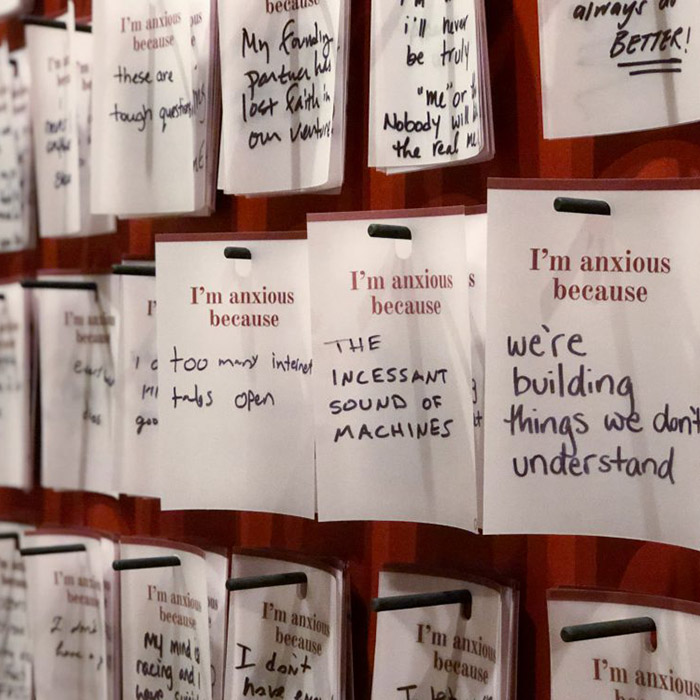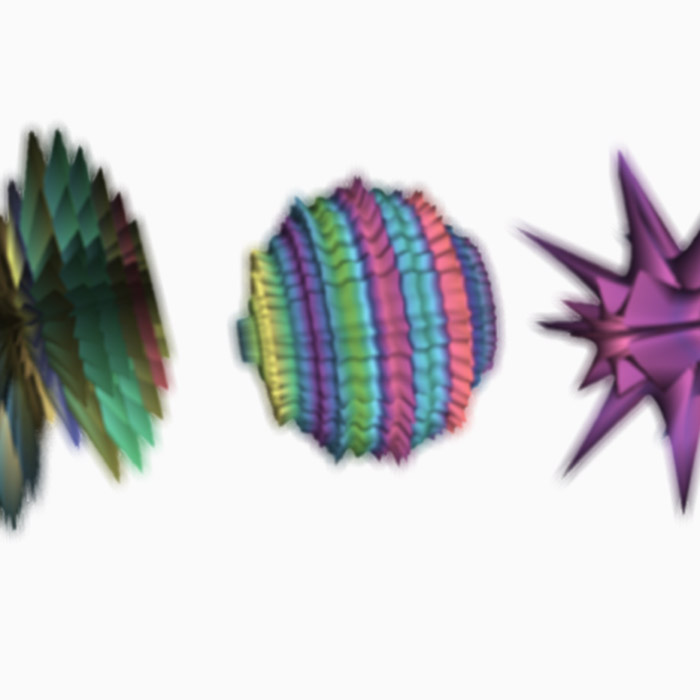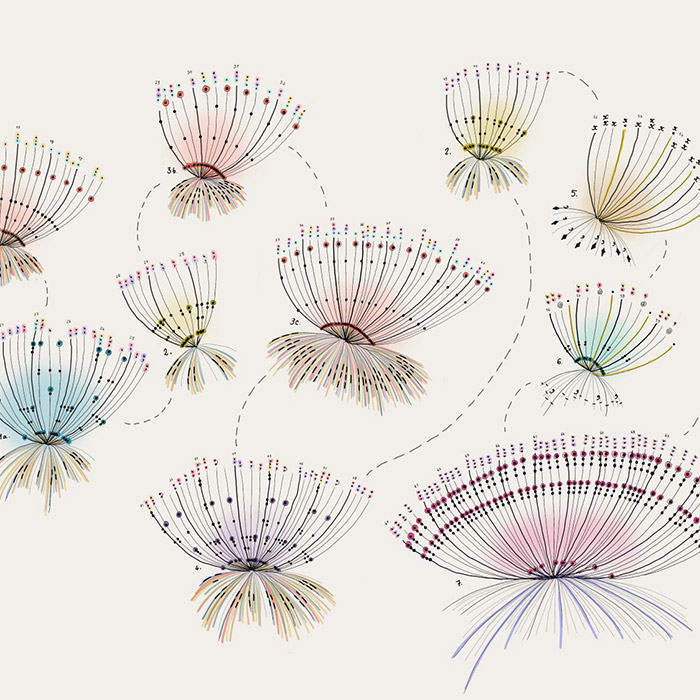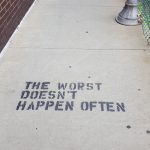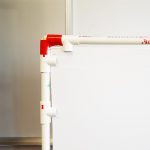This is an evolving list, which (I hope) we’ll be adding to, together, over the project. Back to project overview.
Mental health resources
▶Carnegie Mellon Counseling and Psychological Services
Carnegie Mellon Community Think Tank (2013). The Culture of Stress at Carnegie Mellon.
Seth Vargo (2016). Carnegie Mellon, Mental Illness, and Suicide, 31 March 2016.
Background on Research Through Design and Participatory Design approaches
[to follow]
Projects / methods about modelling or visualising intangible phenomena or data
Specifically on aspects of mental health or related areas
Candy Chang (2018). A Monument for the Anxious and Hopeful.
Brendan Dawes, Ben Koslowski et al (2015). States of Mind
Amber Discko (2017–). Aloe Bud: Your gentle self-care companion.
Laurie Frick (multiple dates), Stress Inventory, Mood+Quantify, and Personality Quirks.
Edward Honaker (2015). Book II project
Igor Kupec (undated). Mental Disorders as Typography. Bored Panda
Giorgia Lupi and Kaki King (2018). Bruises — The data we don’t see.
Mindapples (2008–). Project website.
Alexis Nedd and Andrew Richard (2015). Here’s How 10 People Visualize Their Depression. BuzzFeed, 13 December 2015.
Kara Stone (2014–). Medication Meditation.
Match Studio, University of South Australia (2017 / 18), Visualising Mental Health projects / exhibitions, 2017 and 2018
Jill Simpson (2017). Visualising Mental Illness. openDemocracy, 10 May 2017.
Frank Warren and contributors (2015–). PostSecret.
Sara Wasson (2017). Translating Chronic Pain: Creative Manifesto, Lancaster University
Wellcome Trust (2016–), Created Out Of Mind project
Methods (or collections of methods) more widely applicable
Manuela Aguirre Ulloa and Adrian Paulsen (2017). Co-designing with relationships in mind. Form Akademisk 10(1) 1–14
Flora Bowden, Dan Lockton, Rama Gheerawo, and Clare Brass (2015). Drawing Energy: Exploring Perceptions of the Invisible. London: Royal College of Art.
Priscilla Cheung-Nainby (2013–). Collective Imagery Weave workshops
Denise Gastaldo, Lilian Magalhães, Christine Carrasco, and Charity Davy (2012). Body-Map Storytelling as Research: Methodological considerations for telling the stories of undocumented workers through body mapping.
Dave Gray, Sunni Brown, and James Macanufo (2010). Gamestorming: A Playbook for Innovators, Rulebreakers, and Changemakers. O’Reilly, Sebastopol.
Dave Gray (2016). Liminal Thinking: Create the Change You Want by Changing the Way You Think. Two Waves.
Shruti Grover, Simon Johnson, Ross Atkin, and Chris McGinley (2016). A user centred approach to developing an actionable visualisation for ‘balance health’. Proceedings of DRS 2016, Brighton.
Roy Grubb (2013–). Visual Thinking Center.
Yvonne Jansen and Pierre Dragicevic (2015–). Data Physicalization Wiki.
Helen Kara (2015). Creative Research Methods in the Social Sciences: A practical guide. Policy Press, Bristol.
Marion Lean (2016–). Affective Material Palette.
Chang Hee Lee (2016). Three Studies of Synaesthesia.
Manuel Lima (2011). Visual Complexity: Mapping Patterns of Information. Princeton Architectural Press.
Manuel Lima (2014). The Book of Trees: Visualizing Branches of Knowledge. Princeton Architectural Press.
Dan Lockton (2017–). New Metaphors, Imaginaries Lab blog.
Dan Lockton and Stuart Candy (2018). A Vocabulary for Visions in Designing for Transitions. Proceedings of DRS 2018, Limerick.
Dan Lockton, Delanie Ricketts, Shruti Aditya Chowdhury, and Chang Hee Lee (2017). Exploring Qualitative Displays and Interfaces. In Extended Abstracts of the 2017 CHI Conference on Human Factors in Computing Systems. ACM, New York
Giorgia Lupi (2017). How We Can Find Ourselves In Data. TED Talk.
Giorgia Lupi and Stefanie Posavec (2016). Dear Data. Princeton Architectural Press / Penguin
Deborah Lupton (2018). Using graphic narratives for research translation and engagement. This Sociological Life, 16 August 2018.
Ellen Lupton and Andrea Lipps (2018). The Senses: Design Beyond Vision. Princeton Architectural Press / Cooper Hewitt.
Bella Martin and Bruce Hanington (2012). Universal Methods of Design: 100 Ways to Research Complex Problems, Develop Innovative Ideas, and Design Effective Solutions. Rockport.
Kate McLean (2014–). Sensory Maps.
Bettina Nissen (2013–). Data Things: Engaging People With Data Through Fabrication.
Tristan Partridge (2014) Diagrams in Anthropology: Lines and Interactions. Life off the Grid.
Robert Phillips, Dan Lockton, Sharon Baurley, and Sarah Silve (2013). Making instructions for others: exploring mental models through a simple exercise. Interactions Vol.20 No.5, pp. 74-79
Howard Rheingold. (2017). Concept Mapping & Mindmapping.
Delanie Ricketts and Dan Lockton (2018). Mental Landscapes : Externalizing Mental Models Through Metaphors. Working paper and project details
Julian Rothenstein (editor) (2017). Psychobook: Games, Tests, Questionnaires, Histories. Princeton Architectural Press.
Karianne Rygh (editor) (2013). Value Pursuit. The Readership in Strategic Creativity, Design Academy Eindhoven (link to project)
Karianne Rygh (2016–). Strategic design of affordances and metaphors in tangible tools for co-creation. AHO, Oslo.
Caroline Sinders (2018). How to make research-driven art. The Creative Independent, 16 August 2018.
Miriam Sturdee, Makayla Lewis, and Nicolai Marquardt (2018). SketchBlog #1: The rise and rise of the sketchnote. Interactions blog, 14 August 2018
Roberta Tassi (2008–) Service Design Tools.
Alice Thudt, Uta Hinrichs, Samuel Huron, and Sheelagh Carpendale (2018). Self-Reflection and Personal Physicalization Construction. In Proceedings of the 2018 CHI Conference on Human Factors in Computing Systems. ACM, New York, paper 154.
Martin Tomitsch, Cara Wrigley, Madeleine Borthwick, Naseem Ahmadpour, Jessica Frawley, A. Baki Kocaballi, Claudia Núñez-Pacheco, Karla Straker, and Lian Loke (2018). Design. Think. Make. Break. Repeat. A Handbook of Methods. BIS, Amsterdam.
Josina Vink, Katarina Wetter-Edman, and Manuela Aguirre (2017). Designing for Aesthetic Disruption: Altering Mental Models in Social Systems through Designerly Practices. The Design Journal, 20:sup1, S2168-S2177
Relevant groups and organizations
Experimental Research Methods: Arts & Design Based Methods. Blog, Information Experience Design, RCA.
FOCUS: Network for Advanced Visual & Experimental Research Methods. Group website, Sheffield Hallam / Manchester Metropolitan / RCA.
Goldsmiths, University of London, MA in Visual Sociology / Sociology Methods Lab
Innovative Social Research Methods, Facebook group
University of Pennsylvania, Positive Psychology Center
Writing dealing with mental health and emotions in experiential ways
Mark Brown (2018). What it feels like to hide your mental health problems from your boss. ShortList, 14 August 2018.
Matt Haig (2015). Reasons to Stay Alive. Canongate.
Matt Haig (2018). Notes on a Nervous Planet. Canongate.
Martha C. Nussbaum (2001). Upheavals of Thought: The Intelligence of Emotions. Cambridge University Press.
Theory on mental models and concept mappings
Joseph D. Novak & Alberto J. Cañas (2006). The Theory Underlying Concept Maps and How to Construct and Use Them. IHMC Technical Report.
Yvonne Rogers, Andrew Rutherford, and Peter A. Bibby (editors) (1992). Models in the Mind: Theory, Perspective & Application. Academic Press, San Diego.

